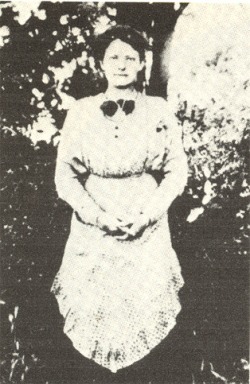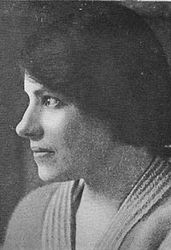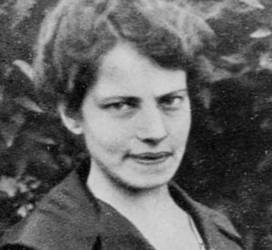Who is Anna Anderson?
Anna Anderson was one of the best known Anastasia imposters, with many people believing her story.
In 1920, Anna Anderson tried to commit a suicide attempt, jumping off of a Berlin bridge.
Having been found alive, she was institutionalized in a mental hospital, where she was named Fräulein Unbekannt, meaning miss unknown in German.
While in the hospital, it is said that she spoke beautiful Russian to her 'cell' mate, a Russian seamstress.
In 1920, Anna Anderson tried to commit a suicide attempt, jumping off of a Berlin bridge.
Having been found alive, she was institutionalized in a mental hospital, where she was named Fräulein Unbekannt, meaning miss unknown in German.
While in the hospital, it is said that she spoke beautiful Russian to her 'cell' mate, a Russian seamstress.
The seamstress' name was Clara Peuthert and in 1920, she began to tell everybody that miss unknown was actually the Grand Duchess Tatiana of Russia, Anastasia's elder sister.
When Clara Peuthert left the institution, she told Captain Nicholas von Schwabe, a Russian émigré, that she had seen Tatiana.
Schwabe then visited the assylum, and accepted that miss unknow was, indeed, Tatiana.
Eventually, word got around, and Baroness Sophie Buxhoeveden, a former lady-in-waiting to the Grand Duchess Tatiana, visited the assylum.
On seeing miss unknown, Sophie explained that when you saw only the girl's forehead and eyes, she slightly resembled the Duchess.
However, she also exclaimed that on further inspection, she was 'too short for Tatiana!', and left convinced that miss unknown was not a Grand Duchess.
Two days later, miss unknown noted "I did not say that I was Tatiana".
By may 1922, Schwabe, Peuthert and another émigré, Tolstoy, all believed that the girl was Anastasia, but Buxhoeveden said that there was no resemblance between miss unknown and the Grand Duchess.
Nevertheless, the girl was taken out of her assylum and was then hosted at the Berlin home of Baron Arthur von Kleist.
Arthur von Kleist was a Russian émigré who had also been a Police Cheif in what was then Russian Poland.
The girl started calling herself Anna Tschaikovsky.
Anna was then met by the Tsarina's sister, Princess Irene of Hesse and by Rhine, but Princess Irene did not recognise her.
There was also a meeting with the Crown Princess Cecilie of Prussia, but Anna refused to speak to her, and Cecilie was left confused by the whole encounter.
When Clara Peuthert left the institution, she told Captain Nicholas von Schwabe, a Russian émigré, that she had seen Tatiana.
Schwabe then visited the assylum, and accepted that miss unknow was, indeed, Tatiana.
Eventually, word got around, and Baroness Sophie Buxhoeveden, a former lady-in-waiting to the Grand Duchess Tatiana, visited the assylum.
On seeing miss unknown, Sophie explained that when you saw only the girl's forehead and eyes, she slightly resembled the Duchess.
However, she also exclaimed that on further inspection, she was 'too short for Tatiana!', and left convinced that miss unknown was not a Grand Duchess.
Two days later, miss unknown noted "I did not say that I was Tatiana".
By may 1922, Schwabe, Peuthert and another émigré, Tolstoy, all believed that the girl was Anastasia, but Buxhoeveden said that there was no resemblance between miss unknown and the Grand Duchess.
Nevertheless, the girl was taken out of her assylum and was then hosted at the Berlin home of Baron Arthur von Kleist.
Arthur von Kleist was a Russian émigré who had also been a Police Cheif in what was then Russian Poland.
The girl started calling herself Anna Tschaikovsky.
Anna was then met by the Tsarina's sister, Princess Irene of Hesse and by Rhine, but Princess Irene did not recognise her.
There was also a meeting with the Crown Princess Cecilie of Prussia, but Anna refused to speak to her, and Cecilie was left confused by the whole encounter.
In the 1950s, Cecilie would sign a declaration that Tsachaikovsky was Anastasia, but her family would dispute her statement, hinting that Cecilie was suffering from dementia.
By 1925, Anna had developed a tuberculous infection in her arm, and grew ill, having to move into many hospitals for treatment.
Becoming sick near death, Anna began to lose weight rapidly.
At one point, Anna was visited by Anastasia's tutor and his wife, who had been Anastasia's nurse maid, as well as the Tsar's sister, Grand Duchess Olga Alexandrovna of Russia.
While they all showed sympathy for Tsachaikovsky's illness, they all denied that she was Anastasia.
Grand Duchess Anastasia's uncle, Prince Vlademar of Denmark, offered to help Anna with getting better, placing her in good hospitals offering her material assistance while her true identity was being discovered.
To allow her to travel, Anna was given a passport for Anastasia Tsachaikovsky, with all of the real Anastasia's personal details, and was returned to Berlin.
Anna was then visited by Tatiana Melnik, daughter of Dr Eugene Botkin, the imperial family's personal physician who was killed along side the Romanov family.
Melnik said that Anna resembled Anastasia, but her mouth had changed and coarsened noticeably, and that because her face was so lean, her nose looked far too big.
In a letter, Melnik wrote: "Her attitude is childlike, and altogether she cannot be reckoned with as a responsible adult, but must be led and directed like a child. She has not only forgotten languages, but has in general lost the power of accurate narration ... even the simplest stories she tells incoherently and incorrectly; they are really only words strung together in impossibly ungrammatical German ... Her defect is obviously in her memory and eyesight."
By 1925, Anna had developed a tuberculous infection in her arm, and grew ill, having to move into many hospitals for treatment.
Becoming sick near death, Anna began to lose weight rapidly.
At one point, Anna was visited by Anastasia's tutor and his wife, who had been Anastasia's nurse maid, as well as the Tsar's sister, Grand Duchess Olga Alexandrovna of Russia.
While they all showed sympathy for Tsachaikovsky's illness, they all denied that she was Anastasia.
Grand Duchess Anastasia's uncle, Prince Vlademar of Denmark, offered to help Anna with getting better, placing her in good hospitals offering her material assistance while her true identity was being discovered.
To allow her to travel, Anna was given a passport for Anastasia Tsachaikovsky, with all of the real Anastasia's personal details, and was returned to Berlin.
Anna was then visited by Tatiana Melnik, daughter of Dr Eugene Botkin, the imperial family's personal physician who was killed along side the Romanov family.
Melnik said that Anna resembled Anastasia, but her mouth had changed and coarsened noticeably, and that because her face was so lean, her nose looked far too big.
In a letter, Melnik wrote: "Her attitude is childlike, and altogether she cannot be reckoned with as a responsible adult, but must be led and directed like a child. She has not only forgotten languages, but has in general lost the power of accurate narration ... even the simplest stories she tells incoherently and incorrectly; they are really only words strung together in impossibly ungrammatical German ... Her defect is obviously in her memory and eyesight."
Melnik later confirmed that Anna was, infact, Anastasia, and supposed that any inability on her part to remember events and her refusal to speak Russian was caused by her impaired physical and psychological state.
Anna soon moved to America under the name of Anna Anderson.
Before her visa expired, she married John Eacott Manahan, who was 20 years younger than her.
In January 1984, she may have had a stroke, and on 12 February 1984, she died of pneumonia.
Before her visa expired, she married John Eacott Manahan, who was 20 years younger than her.
In January 1984, she may have had a stroke, and on 12 February 1984, she died of pneumonia.
Find more information at http://en.wikipedia.org/wiki/Anna_Anderson!
*
So who was Anna Anderson, really?

Anna Anderson was actually Franziska Schanzkowska, a polish factory worker.
She had worked in a munitions factory during World War 1.
Shortly after her fiancé had been killed on the front line, Franziska accidentally dropped a grenade, which exploded.
She was injured in the head, and a foreman was killed before her.
She became apathetic and depressed, and was declared insane on 19th september, 1916.
She had worked in a munitions factory during World War 1.
Shortly after her fiancé had been killed on the front line, Franziska accidentally dropped a grenade, which exploded.
She was injured in the head, and a foreman was killed before her.
She became apathetic and depressed, and was declared insane on 19th september, 1916.
How can we be sure that her claim was wrong?
After Anna Anderson died, her DNA was compared with that of living relatives of the Romanovs.
Her DNA was not a match.
Infact, her DNA matched that of Karl Maucher, a great-nephew of Franziska Schanzkowska.
In 2008, Anastasia's bones were discovered and identified.
Anna Anderson, or Franziska Schanzkowska was a fraud, who sadly had deep psychological problems, living a lie so long that in the end, she actually thought she was the Grand Duchess Anastasia Romanov.
Her DNA was not a match.
Infact, her DNA matched that of Karl Maucher, a great-nephew of Franziska Schanzkowska.
In 2008, Anastasia's bones were discovered and identified.
Anna Anderson, or Franziska Schanzkowska was a fraud, who sadly had deep psychological problems, living a lie so long that in the end, she actually thought she was the Grand Duchess Anastasia Romanov.



